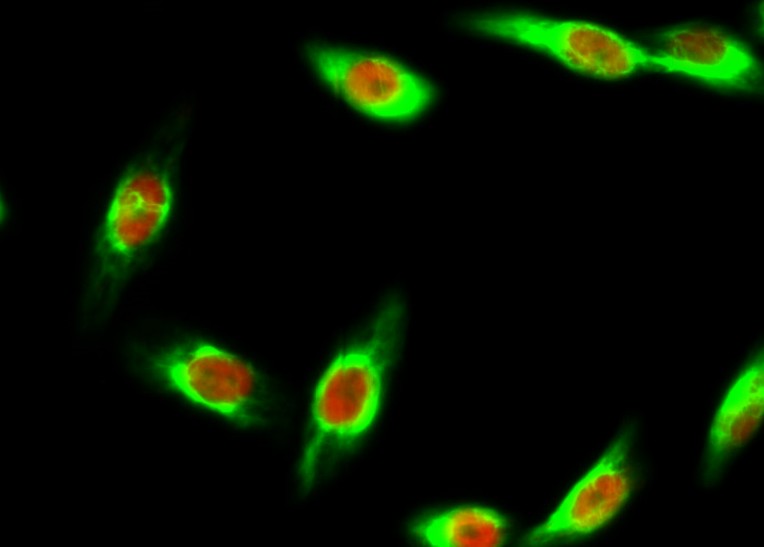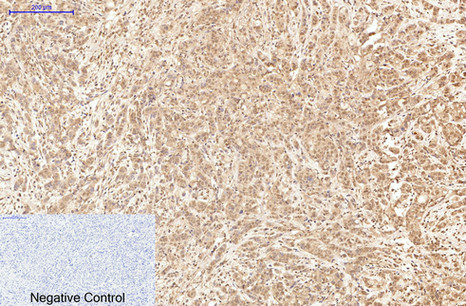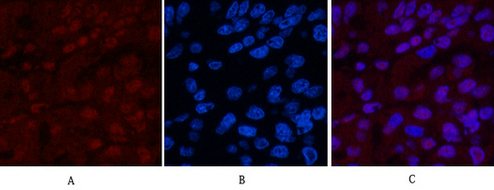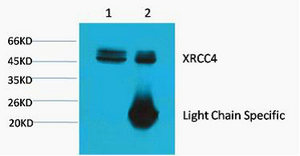XRCC4 Monoclonal Antibody(5C10)
- 货号:YM3086
- 应用:WB;IHC;IF;IP
- 种属:Human
- 简介:
- >>Non-homologous end-joining
- 蛋白名称:
- DNA repair protein XRCC4
- 免疫原:
- Synthetic Peptide of XRCC4
- 特异性:
- The antibody detects endogenous XRCC4 proteins.
- 组成:
- PBS, pH 7.4, containing 0.5%BSA, 0.02% sodium azide as Preservative and 50% Glycerol.
- 稀释:
- WB 1:2000 IP:1:200 IF 1:200 IHC 1:50-300
- 纯化工艺:
- The antibody was affinity-purified from mouse ascites by affinity-chromatography using specific immunogen.
- 储存:
- -15°C to -25°C/1 year(Do not lower than -25°C)
- 其他名称:
- XRCC4;DNA repair protein XRCC4;X-ray repair cross-complementing protein 4
- 背景:
- The protein encoded by this gene functions together with DNA ligase IV and the DNA-dependent protein kinase in the repair of DNA double-strand breaks. This protein plays a role in both non-homologous end joining and the completion of V(D)J recombination. Mutations in this gene can cause short stature, microcephaly, and endocrine dysfunction (SSMED). Alternative splicing generates several transcript variants. [provided by RefSeq, Dec 2015],
- 功能:
- function:Involved in DNA non-homologous end joining (NHEJ) required for double-strand break repair and V(D)J recombination. Binds to DNA and to DNA ligase IV (LIG4). The LIG4-XRCC4 complex is responsible for the NHEJ ligation step, and XRCC4 enhances the joining activity of LIG4. Binding of the LIG4-XRCC4 complex to DNA ends is dependent on the assembly of the DNA-dependent protein kinase complex DNA-PK to these DNA ends.,PTM:Monoubiquitinated.,PTM:Phosphorylated by PRKDC. The phosphorylation seems not to be necessary for binding to DNA. Phosphorylation by CK2 promotes interaction with APTX.,PTM:Sumoylation at Lys-210 is required for nuclear localization and recombination efficiency. Has no effect on ubiquitination.,similarity:Belongs to the XRCC4 family.,subunit:Homodimer and homotetramer in solution. The homodimer associates with LIG4, and the LIG4-XRCC4 complex associates in a DNA-dep
- 细胞定位:
- Nucleus . Chromosome . Localizes to site of double-strand breaks. .; [Protein XRCC4, C-terminus]: Cytoplasm . Translocates from the nucleus to the cytoplasm following cleavage by caspase-3 (CASP3). .

- Immunofluorescence analysis of Hela cell. 1,Bak Polyclonal Antibody(green) was diluted at 1:200(4° overnight). (red) was diluted at 1:200(4° overnight). 2, Goat Anti Rabbit Alexa Fluor 488 Catalog:RS3211 was diluted at 1:1000(room temperature, 50min). Goat Anti Mouse Alexa Fluor 594 Catalog:RS3608 was diluted at 1:1000(room temperature, 50min).

- Immunohistochemical analysis of paraffin-embedded Human-breast-cancer tissue. 1,XRCC4 Monoclonal Antibody(5C10) was diluted at 1:200(4°C,overnight). 2, Sodium citrate pH 6.0 was used for antibody retrieval(>98°C,20min). 3,Secondary antibody was diluted at 1:200(room tempeRature, 30min). Negative control was used by secondary antibody only.

- Immunofluorescence analysis of Human-liver-cancer tissue. 1,XRCC4 Monoclonal Antibody(5C10)(red) was diluted at 1:200(4°C,overnight). 2, Cy3 labled Secondary antibody was diluted at 1:300(room temperature, 50min).3, Picture B: DAPI(blue) 10min. Picture A:Target. Picture B: DAPI. Picture C: merge of A+B

- Western blot analysis of 1) Hela, 2) 293T, diluted at 1:3000.

- 1) Input: Hela Cell Lysate
2) IP product: IP dilute 1:200







